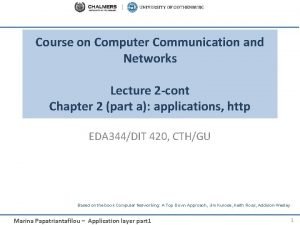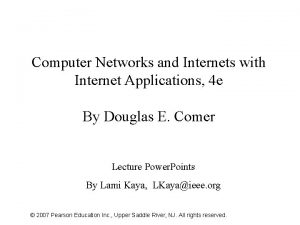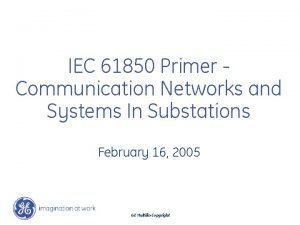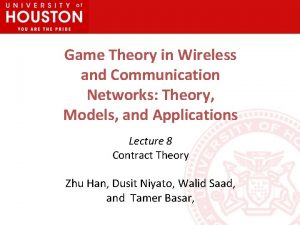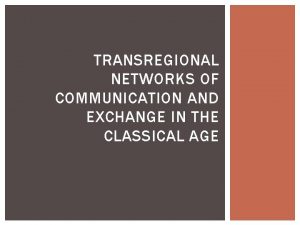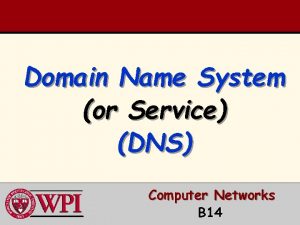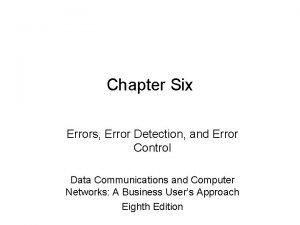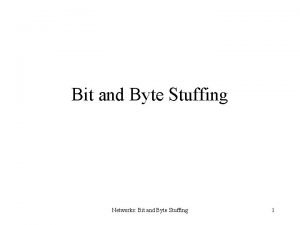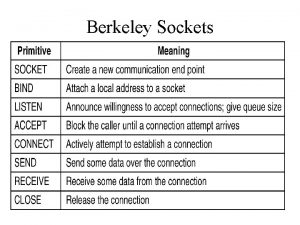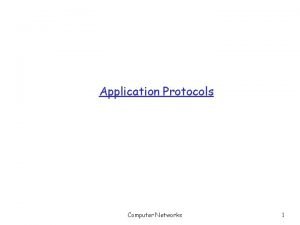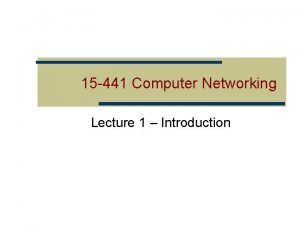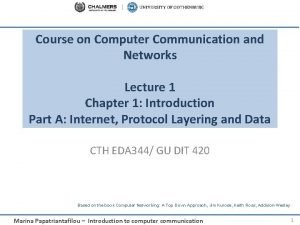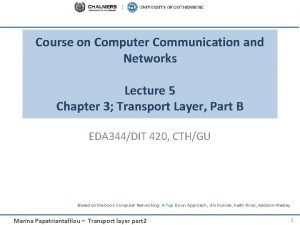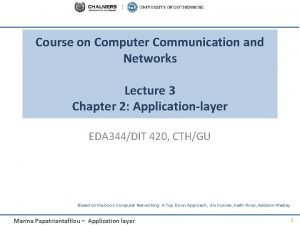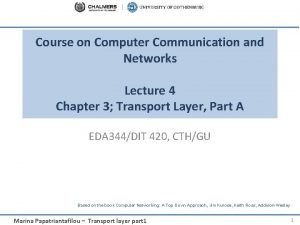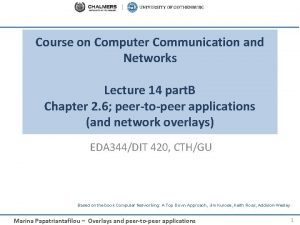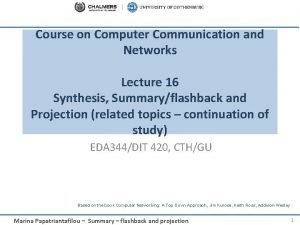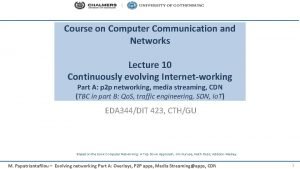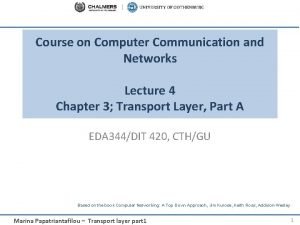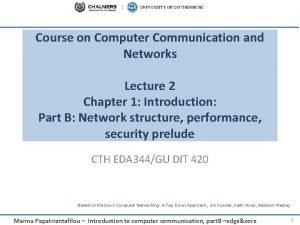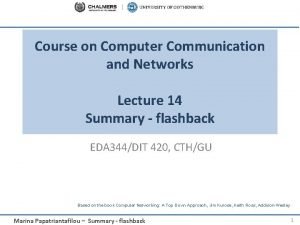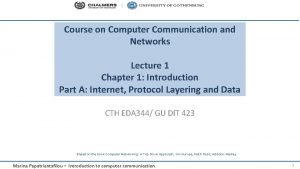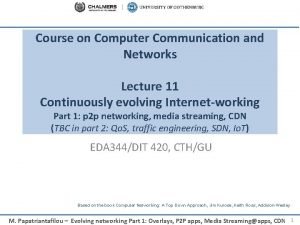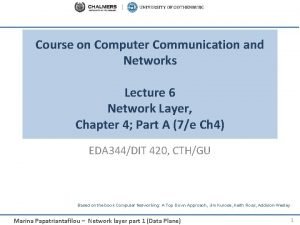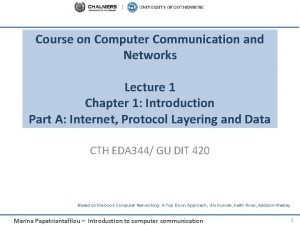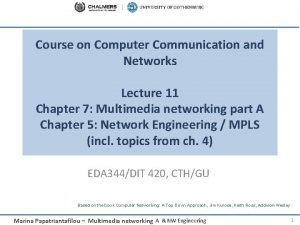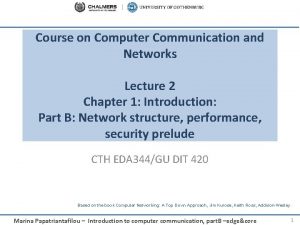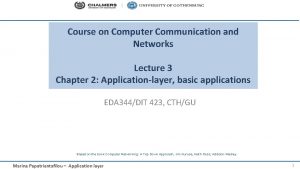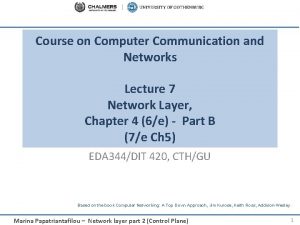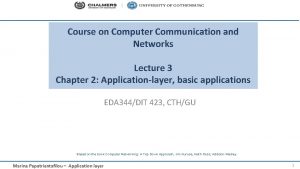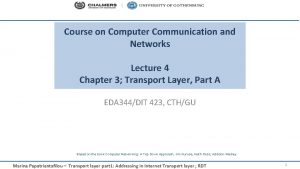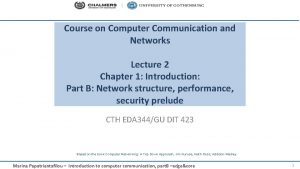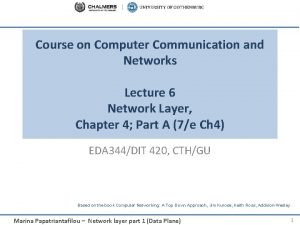Course on Computer Communication and Networks Lecture 4













![UDP: User Datagram Protocol [RFC 768] “best effort” service, UDP segments may be: – UDP: User Datagram Protocol [RFC 768] “best effort” service, UDP segments may be: –](https://slidetodoc.com/presentation_image_h/d7fd5ed90c2335c99455df5a7c8614f2/image-14.jpg)

![UDP Checksum[RFC 1071]: check bit flips Sender: Receiver: r treat segment contents as r UDP Checksum[RFC 1071]: check bit flips Sender: Receiver: r treat segment contents as r](https://slidetodoc.com/presentation_image_h/d7fd5ed90c2335c99455df5a7c8614f2/image-16.jpg)






































- Slides: 54

Course on Computer Communication and Networks Lecture 4 Chapter 3; Transport Layer, Part A EDA 344/DIT 420, CTH/GU Based on the book Computer Networking: A Top Down Approach, Jim Kurose, Keith Ross, Addison-Wesley. Marina Papatriantafilou – Transport layer part 1 1

Transport services and protocols l ca d en d- en rt po ns tra – send side: breaks app messages into segments, passes to network layer – rcv side: reassembles segments into messages, passes to app layer application transport network data link physical gi lo • provide logical communication to app processes • transport protocols run in end systems application transport network data link physical • transport protocols available to apps – Internet: TCP and UDP Marina Papatriantafilou – Transport layer part 1 Transport Layer 3 -2

Internet transport-layer protocols • reliable, in-order delivery: TCP; also provides network data link physical rt network data link physical po ns tra Marina Papatriantafilou – Transport layer part 1 network data link physical nd Both support addressing (multiplexing) Transport Layer services not available in TCP & UDP: Delay/bandwidth guarantees -e nd – no-frills extension of “besteffort” IP network data link physical le • unreliable, unordered delivery: UDP network data link physical ca gi lo – flow control – congestion control – connection setup Recall: best-effort datagram service application transport network data link physical 3 -3

Transport Layer: Learning goals: • understand principles behind transport layer services: – Addressing, multiplexing/demultiplexing – reliable data transfer – flow control – congestion control (not mainly a Transport-layer issue --some study now; more in connection with Real. Time traffic) • instantiation and implementation in the Internet Marina Papatriantafilou – Transport layer part 1 3 a-4

Roadmap • • Transport layer services in Internet Addressing, multiplexing/demultiplexing Connectionless, unreliable transport: UDP principles of reliable data transfer • Next lecture: connection-oriented transport: TCP – reliable transfer – flow control – connection management – TCP congestion control Marina Papatriantafilou – Transport layer part 1 3 a-5

Addressing: Multiplexing/demultiplexing Multiplexing at send host: gathering data, enveloping data with header (later used for demultiplexing) Demultiplexing at rcv host: delivering received segments to correct socket = socket application = process P 3 P 1 application transport network link physical host 1 P 2 P 4 application transport network link physical host 2 host 3 Recall: segment - unit of data exchanged between transport layer entities aka TPDU: transport protocol data unit Marina Papatriantafilou – Transport layer part 1 3 a-6

Addressing v Host receives IP datagrams § datagram has source IP address, destination IP address § datagram carries transportlayer segment § segment has source, destination port number v Host uses IP addresses & port numbers to direct segment to appropriate socket 32 bits source port # dest port # other header fields application data (payload) TCP/UDP segment format Marina Papatriantafilou – Transport layer part 1 Transport Layer 3 -7

UDP addressing - demultiplexing created socket has host-local port #, eg: v when host receives UDP segment: § directs UDP segment to socket with that port # Marina Papatriantafilou – Transport layer part 1 Datagram. Socket my. Socket 1 = new Datagram. Socket(12534); IP datagrams with same dest. port #, but different source IP addresses and/or source port numbers will be directed to the same socket 3 -8

UDP : example Datagram. Socket my. Socket 2 = new Datagram. Socket (9157); Datagram. Socket server. Socket = new Datagram. Socket (6428); Datagram. Socket my. Socket 1 = new Datagram. Socket (5775); application P 1 P 3 P 4 transport network link physical source port: 6428 dest port: 9157 source port: 9157 dest port: 6428 Marina Papatriantafilou – Transport layer part 1 source port: ? dest port: ? 3 -9

Connection-oriented (TCP) addressing/demux • TCP socket identified by • server host may support many simultaneous TCP 4 -tuple: sockets: § source IP address § source port number § dest IP address § dest port number • one socket per connection • each socket identified by its own 4 -tuple • demux: receiver uses all four values to direct • web servers have segment to appropriate different sockets for socket each connecting client Marina Papatriantafilou – Transport layer part 1 3 -10

TCP: example application P 4 P 3 P 5 application P 6 P 2 P 3 transport network link physical host: IP address A server: IP address B source IP, port: B, 80 dest IP, port: A, 9157 source IP, port: A, 9157 dest IP, port: B, 80 three segments, all destined to IP address: B, dest port: 80 are demultiplexed to different sockets Marina Papatriantafilou – Transport layer part 1 physical source IP, port: C, 5775 dest IP, port: B, 80 host: IP address C source IP, port: C, 9157 dest IP, port: B, 80 Transport Layer 3 -11

TCP demux: Threaded web server threaded server application P 4 P 3 P 2 P 3 transport network link physical host: IP address A server: IP address B source IP, port: B, 80 dest IP, port: A, 9157 source IP, port: A, 9157 dest IP, port: B, 80 Marina Papatriantafilou – Transport layer part 1 physical source IP, port: C, 5775 dest IP, port: B, 80 host: IP address C source IP, port: C, 9157 dest IP, port: B, 80 Transport Layer 3 -12

Roadmap • • Transport layer services Addressing, multiplexing/demultiplexing Connectionless, unreliable transport: UDP principles of reliable data transfer • Next lecture: connection-oriented transport: TCP – reliable transfer – flow control – connection management – TCP congestion control Marina Papatriantafilou – Transport layer part 1 3 a-13
![UDP User Datagram Protocol RFC 768 best effort service UDP segments may be UDP: User Datagram Protocol [RFC 768] “best effort” service, UDP segments may be: –](https://slidetodoc.com/presentation_image_h/d7fd5ed90c2335c99455df5a7c8614f2/image-14.jpg)
UDP: User Datagram Protocol [RFC 768] “best effort” service, UDP segments may be: – lost – delivered out-of-order • connectionless: – no handshaking between UDP sender, receiver – each UDP segment handled independently of others Marina Papatriantafilou – Transport layer part 1 Transport Layer 3 -14

UDP: segment header 32 bits source port # dest port # length checksum UDP use: • DNS • SNMP length, in bytes of • More discussion UDP datagram, later… including header why is there a UDP? application data (payload) UDP datagram format Marina Papatriantafilou – Transport layer part 1 • Must do the addressing job • no connection establishment (which could add delay) • simple: no connection state at sender, receiver • small header size • no congestion control: UDP can blast away segments faster (than TCP) Transport Layer 3 -15
![UDP ChecksumRFC 1071 check bit flips Sender Receiver r treat segment contents as r UDP Checksum[RFC 1071]: check bit flips Sender: Receiver: r treat segment contents as r](https://slidetodoc.com/presentation_image_h/d7fd5ed90c2335c99455df5a7c8614f2/image-16.jpg)
UDP Checksum[RFC 1071]: check bit flips Sender: Receiver: r treat segment contents as r compute checksum of received sequence of 16 -bit integers r checksum: addition (1’s complement sum) of segment contents r sender puts checksum value into UDP checksum field segment r check if computed checksum equals checksum field value: m NO - error detected (report error to app or discard) m YES - no error detected. • But maybe (rarely) errors nonethless? More later …. 1 1 0 0 1 1 1 0 1 0 1 Wraparound: 1 1 0 1 1 Add to final sum checksum 1 1 0 1 1 0 0 0 1 0 0 1 1 Marina Papatriantafilou – Transport layer part 1 3 -16

Roadmap • • Transport layer services Addressing, multiplexing/demultiplexing Connectionless, unreliable transport: UDP principles of reliable data transfer • Next lecture: connection-oriented transport: TCP – reliable transfer – flow control – connection management – TCP congestion control Marina Papatriantafilou – Transport layer part 1 3 a-17

Principles of reliable data transfer top-10 list of important networking topics! characteristics of unreliable channel will determine complexity of reliable data transfer protocol (rdt) Marina Papatriantafilou – Transport layer part 1 3 -18

Reliable data transfer (RDT): getting started rdt_send(): called from above, (e. g. , by app. ). Passed data to deliver to receiver upper layer deliver_data(): called by rdt to deliver data to upper send side udt_send(): called by rdt, to transfer packet over unreliable channel to receiver Marina Papatriantafilou – Transport layer part 1 receive side rdt_rcv(): called when packet arrives on rcv-side of channel Transport Layer 3 -19

Is it possible to have reliable transfer over UDP? Marina Papatriantafilou – Transport layer part 1 20

reliable transfer over UDP? • add reliability at application layer • application-specific error recovery • But best to: not “reinvent “TCP on top of UDP • i. e. . if you need TCP, use TCP Marina Papatriantafilou – Transport layer part 1 21

RDT: S application: Author Writes and Sends pages S transport: secretary Alice Must send pages on behalf of author R application: publisher Receives & publishes written pages S transport: secretary Bob Receives pages; Must pass on to publisher in-order Birirectional 1 -page-at-a-time-MMS connection A sends one page at a time; How do A & B do their job if MMS connection… • …is reliable? • …might introduce errors? • …might lose MMSs? Marina Papatriantafilou – Transport layer part 1 22

Reliable data transfer: getting started we’ll: • incrementally develop sender, receiver sides of reliable data transfer protocol (rdt) • consider only unidirectional data transfer – but control info will flow on both directions! • use finite state machines (FSM) to specify sender, event causing state transition receiver actions taken on state transition state: when in this “state” next state uniquely determined by next event state 1 Marina Papatriantafilou – Transport layer part 1 event actions state 2 3 -23

rdt 1. 0: reliable transfer & reliable channel v underlying channel perfectly reliable § no bit errors § no loss of packets v separate FSMs for sender, receiver: § sender sends data into underlying channel § receiver reads data from underlying channel Wait for call from above rdt_send(data) packet = make_pkt(data) udt_send(packet) sender Marina Papatriantafilou – Transport layer part 1 Wait for call from below rdt_rcv(packet) extract (packet, data) deliver_data(data) receiver 3 -24

rdt 2. 0: channel with bit errors • underlying channel may flip bits in packet • checksum to detect bit errors • how to recover from errors: • acknowledgements (ACKs): receiver explicitly tells sender that pkt received OK • negative acknowledgements (NAKs): receiver explicitly tells sender that pkt had errors • sender retransmits pkt on receipt of NAK • new mechanisms in rdt 2. 0 (beyond rdt 1. 0): • error detection • feedback: control msgs (ACK, NAK) from receiver to sender Marina Papatriantafilou – Transport layer part 1 3 -25

rdt 2. 0: FSM specification rdt_send(data) sndpkt = make_pkt(data, checksum) udt_send(sndpkt) rdt_rcv(rcvpkt) && is. NAK(rcvpkt) Wait for call from ACK or udt_send(sndpkt) above NAK rdt_rcv(rcvpkt) && is. ACK(rcvpkt) L sender receiver rdt_rcv(rcvpkt) && corrupt(rcvpkt) udt_send(NAK) Wait for call from below rdt_rcv(rcvpkt) && notcorrupt(rcvpkt) extract(rcvpkt, data) deliver_data(data) udt_send(ACK) Marina Papatriantafilou – Transport layer part 1 3 -26

rdt 2. 0: operation with no errors rdt_send(data) snkpkt = make_pkt(data, checksum) udt_send(sndpkt) rdt_rcv(rcvpkt) && is. NAK(rcvpkt) Wait for call from ACK or udt_send(sndpkt) above NAK rdt_rcv(rcvpkt) && corrupt(rcvpkt) udt_send(NAK) rdt_rcv(rcvpkt) && is. ACK(rcvpkt) Wait for call from below L rdt_rcv(rcvpkt) && notcorrupt(rcvpkt) extract(rcvpkt, data) deliver_data(data) udt_send(ACK) Marina Papatriantafilou – Transport layer part 1 Transport Layer 3 -27

rdt 2. 0: error scenario rdt_send(data) snkpkt = make_pkt(data, checksum) udt_send(sndpkt) rdt_rcv(rcvpkt) && is. NAK(rcvpkt) Wait for call from ACK or udt_send(sndpkt) above NAK rdt_rcv(rcvpkt) && corrupt(rcvpkt) udt_send(NAK) rdt_rcv(rcvpkt) && is. ACK(rcvpkt) Wait for call from below L rdt_rcv(rcvpkt) && notcorrupt(rcvpkt) extract(rcvpkt, data) deliver_data(data) udt_send(ACK) Marina Papatriantafilou – Transport layer part 1 Transport Layer 3 -28

rdt 3. 0: channels with errors and loss new assumption: underlying channel can also lose packets (data, ACKs) approach: sender waits “reasonable” amount of time for ACK • retransmits if no ACK received in this time • requires countdown timer • if pkt (or ACK) just delayed (not lost): – Must handle duplicates -> Marina Papatriantafilou – Transport layer part 1 handling duplicates: • sender adds sequence number to each pkt • receiver discards (doesn’t deliver up) duplicate pkt 3 -34

rdt 3. 0 in action receiver send pkt 0 rcv ack 0 send pkt 1 rcv ack 1 send pkt 0 ack 0 pkt 1 ack 1 pkt 0 ack 0 send pkt 0 rcv pkt 0 send ack 0 rcv pkt 1 send ack 1 rcv pkt 0 send ack 0 (a) no loss receiver sender rcv ack 0 send pkt 1 pkt 0 ack 0 rcv pkt 0 send ack 0 pkt 1 X loss timeout resend pkt 1 rcv ack 1 send pkt 0 pkt 1 ack 1 pkt 0 ack 0 rcv pkt 1 send ack 1 rcv pkt 0 send ack 0 (b) packet loss Marina Papatriantafilou – Transport layer part 1 Transport Layer 3 -36

rdt 3. 0 in action receiver send pkt 0 rcv ack 0 send pkt 1 ack 0 pkt 1 ack 1 X rcv pkt 0 send ack 0 timeout resend pkt 1 rcv ack 1 send pkt 0 pkt 1 ack 1 pkt 0 ack 0 send pkt 0 rcv ack 0 send pkt 1 rcv pkt 1 send ack 1 rcv pkt 1 (detect duplicate) send ack 1 rcv pkt 0 send ack 0 (c) ACK loss Marina Papatriantafilou – Transport layer part 1 pkt 0 ack 0 pkt 1 ack 1 timeout loss receiver sender resend pkt 1 rcv ack 1 send pkt 0 pkt 1 rcv pkt 0 send ack 0 rcv pkt 1 send ack 1 rcv pkt 1 pkt 0 ack 1 ack 0 pkt 0 (detect duplicate) ack 0 (detect duplicate) send ack 1 rcv pkt 0 send ack 0 (d) premature timeout/ delayed ACK 3 -37

Roadmap • • Transport layer services in Internet Addressing, multiplexing/demultiplexing Connectionless, unreliable transport: UDP principles of reliable data transfer – Efficiency perspective • Next lecture: connection-oriented transport: TCP – reliable transfer – flow control – connection management – TCP congestion control Marina Papatriantafilou – Transport layer part 1 3 a-38

Performance of rdt 3. 0 • rdt 3. 0 is correct, but performance stinks • e. g. : 1 Gbps link, 15 ms prop. delay, 8000 bit packet: L 8000 bits Dtrans = R = 9 10 bits/sec sender RTT = 8 microsecs receiver first packet bit arrives last packet bit arrives, send ACK arrives, send next packet, t = RTT + L / R Marina Papatriantafilou – Transport layer part 1 Transport Layer 3 -39

Performance of rdt 3. 0 (cont) § Utilization (fraction of time sender busy sending, or fraction of utilized bandwidth ): § if RTT=30 msec, 1 KB pkt every 30 msec: we get 330 kbps throughput over a 1 Gbps link v network protocol limits use of physical resources! Marina Papatriantafilou – Transport layer part 1 Transport Layer 3 -40

Is RDT necessarily that slow/inefficient? Marina Papatriantafilou – Transport layer part 1 41

Pipelined protocols pipelining: sender allows multiple, “in-flight”, yetto-be-acknowledged pkts – range of sequence numbers must be increased – buffering at sender and/or receiver Marina Papatriantafilou – Transport layer part 1 Transport Layer 3 -42

Pipelining: increased utilization sender receiver first packet bit transmitted, t = 0 last bit transmitted, t = L / R RTT first packet bit arrives last packet bit arrives, send ACK last bit of 2 nd packet arrives, send ACK last bit of 3 rd packet arrives, send ACK arrives, send next packet, t = RTT + L / R 3 -packet pipelining increases utilization by a factor of 3! Marina Papatriantafilou – Transport layer part 1 Transport Layer 3 -43

Pipelined protocols: ack-based error control if data is lost, two generic forms of pipelined protocols: go-Back-n, selective repeat Marina Papatriantafilou – Transport layer part 1 Transport Layer 3 -44

Go-Back-n: sender • “window” of up to N, consecutive unack’ed pkts allowed • • • ACK(n): ACKs all pkts up to, including seq # n “cumulative ACK” • may receive duplicate ACKs (see receiver) timer for oldest in-flight pkt timeout(n): retransmit packet n and all higher seq # pkts in window Marina Papatriantafilou – Transport layer part 1 Transport Layer 3 -45

GBn in action sender window (N=4) 012345678 012345678 sender send pkt 0 send pkt 1 send pkt 2 send pkt 3 (wait) rcv ack 0, send pkt 4 rcv ack 1, send pkt 5 ignore duplicate ACK pkt 2 timeout 012345678 send pkt 2 pkt 3 pkt 4 pkt 5 Marina Papatriantafilou – Transport layer part 1 receiver Xloss receive pkt 0, send ack 0 receive pkt 1, send ack 1 receive pkt 3, discard, (re)send ack 1 receive pkt 4, discard, (re)send ack 1 receive pkt 5, discard, (re)send ack 1 rcv rcv pkt 2, pkt 3, pkt 4, pkt 5, deliver, send ack 2 ack 3 ack 4 ack 5 3 -46

Selective repeat • receiver individually acknowledges all correctly received pkts – buffers pkts, as needed, for eventual in-order delivery to upper layer • sender only resends pkts for which ACK not received – sender timer for each un. ACKed pkt • sender window – N consecutive seq #’s – limits seq #s of sent, un. ACKed pkts Marina Papatriantafilou – Transport layer part 1 Transport Layer 3 -47

Selective repeat: sender, receiver windows Marina Papatriantafilou – Transport layer part 1 Transport Layer 3 -48

Selective repeat sender data from above: v if next available seq # in window, send pkt timeout(n): receiver pkt n in [rcvbase, rcvbase+N-1] v v resend pkt n, restart timer ACK(n) in [sendbase, sendbase+N]: v mark pkt n as received v if n smallest un. ACKed pkt, advance window base to next un. ACKed seq # Marina Papatriantafilou – Transport layer part 1 send ACK(n) out-of-order: buffer in-order: deliver (also deliver buffered, inorder pkts), advance window to next not-yetreceived pkt n in [rcvbase-N, rcvbase-1] v ACK(n) otherwise: v ignore Transport Layer 3 -49

Selective repeat in action sender window (N=4) 012345678 012345678 sender send pkt 0 send pkt 1 send pkt 2 send pkt 3 (wait) receiver Xloss rcv ack 0, send pkt 4 rcv ack 1, send pkt 5 record ack 3 arrived pkt 2 timeout receive pkt 0, send ack 0 receive pkt 1, send ack 1 receive pkt 3, buffer, send ack 3 receive pkt 4, buffer, send ack 4 receive pkt 5, buffer, send ack 5 send pkt 2 012345678 record ack 4 arrived record ack 5 arrived rcv pkt 2; deliver pkt 2, pkt 3, pkt 4, pkt 5; send ack 2 Q: what happens when ack 2 arrives? Marina Papatriantafilou – Transport layer part 1 3 -50

Sequence numbers receiver window (after receipt) sender window (after receipt) 0123012 pkt 0 example: 0123012 pkt 1 0123012 • seq #’s: 0, 1, 2, 3 • window size=3 0123012 pkt 2 0123012 pkt 3 v v receiver sees no difference in two scenarios! duplicate data accepted as new in (b) Q: what relationship between seq # size and window size to avoid problem in (b)? Marina Papatriantafilou – Transport layer part 1 0123012 X pkt 0 (a) no problem will accept packet with seq number 0 receiver can’t see sender side. receiver behavior identical in both cases! something’s (very) wrong! 0123012 pkt 0 0123012 pkt 1 0123012 pkt 2 0123012 X X timeout retransmit pkt 0 X 0123012 pkt 0 (b) oops! Transport Layer will accept packet with seq number 0 3 -51

Question What do Ack’s achieve besides reliability? Flow control: receiver can ack its receiving capacity i. e. avoid swamping the receiver Flow control: Sender/receiver problem: S cares to not overwhelm R Marina Papatriantafilou – Transport layer part 1 52

Ack-based pipelining => flow control at the same time!!! sender receiver first packet bit transmitted, t = 0 last bit transmitted, t = L / R RTT first packet bit arrives last packet bit arrives, send ACK last bit of 2 nd packet arrives, send ACK last bit of 3 rd packet arrives, send ACK arrives, send next packet, t = RTT + L / R Flow control: Sender/receiver problem; S cares to not overwhelm R Marina Papatriantafilou – Transport layer part 1 3 b-53

Question: Is congestion control the same as flow control? • No! • Congestion control = Avoid congesting the network • Congestion is network core issue (in contrast to flowcontrol, which is senderreceiver issue) Marina Papatriantafilou – Transport layer part 1 54

Roadmap • • Transport layer services Addressing, multiplexing/demultiplexing Connectionless, unreliable transport: UDP principles of reliable data transfer • Next lecture: connection-oriented transport: TCP – reliable transfer – flow control – connection management – TCP congestion control Marina Papatriantafilou – Transport layer part 1 3 a-55

Reading instructions chapter 3 • • Kurose. Ross book Careful Quick 3. 1, 3. 2, 3. 4 -3. 7 3. 3 Other resources (further, optional study) – Lakshman, T. V. , Upamanyu Madhow, and Bernhard Suter. "Window-based error recovery and flow control with a slow acknowledgement channel: a study of TCP/IP performance. " INFOCOM'97. Sixteenth Annual Joint Conference of the IEEE Computer and Communications Societies. Proceedings IEEE. Vol. 3. IEEE, 1997. – Rizzo, Luigi. "Effective erasure codes for reliable computer communication protocols. " ACM SIGCOMM Computer Communication Review 27. 2 (1997): 24 -36. – A. Agarwal and M. Charikar, “On the advantage of network coding for improving network throughput, ” in Proceedings of the IEEE Information Theory Workshop, Oct. 2004 Harvey, N. J. , Kleinberg, R. , & Lehman, A. R. (2006). On the capacity of information networks. IEEE/ACM Transactions on Networking (TON), 14(SI), 2345 -2364. – Marina Papatriantafilou – Transport layer part 1 Transport Layer 3 -56

Some review questions on this part • Why do we need an extra protocol, i. e. UDP, to deliver the datagram service of Internets IP to the applications? • Draw space-time diagrams without errors and with errors, for the following, for a pair of sender-receive S-R: (assume only 1 link between them) – Stop-and-wait: transmission delay < propagation delay and transmission delay > propagation delay – Sliding window aka pipelined protocol, with window’s transmission delay < propagation delay and window’s transmission delay > propagation delay; illustrate both go-back-n and selective repeat when there are errors – Show to compute the effective throughput between S-R in the above cases, when there are no errors Marina Papatriantafilou – Transport layer part 1 3 a-57

Review questions cont. • What are the goals of reliable data transfer? • Reliable data transfer: show why we need sequence numbers when the sender may retransmit due to timeouts. • Show there can be wraparound in a reliable data transfer session if the sequence-numbers range is not large enough. • Describe the go-back-N and selective repeat methods for reliable data transfer Marina Papatriantafilou – Transport layer part 1 3 a-58

Extra slides, for further study Marina Papatriantafilou – Transport layer part 1 3: Transport Layer 3 a-59

Bounding sequence numbers for stop-and-wait… … s. t. no wraparound, i. e. we do not run out of numbers: binary value suffices for stop-and-wait: Proof sketch: assume towards a contradiction that there is wraparound when we use binary seq. nums. – R expects segment #f, receives segment #(f+2): R rec. f+2 => S sent f+2 => S rec. ack for f+1 => R ack f+1=> R ack f => contradiction – R expects f+2, receives f: R exp. f+2 => R ack f+1 => S sent f+1 => S rec. ack for f => contradiction Marina Papatriantafilou – Transport layer part 1 3: Transport Layer 3 a-60
 Virtual and datagram networks
Virtual and datagram networks Backbone networks in computer networks
Backbone networks in computer networks 01:640:244 lecture notes - lecture 15: plat, idah, farad
01:640:244 lecture notes - lecture 15: plat, idah, farad Computer communication course
Computer communication course Course number and title
Course number and title Difference between intserv and diffserv
Difference between intserv and diffserv Error detection in computer networks
Error detection in computer networks Byte stuffing example
Byte stuffing example Bit stuffing hdlc
Bit stuffing hdlc What is the reverse request protocol
What is the reverse request protocol Analog and digital signals in computer networking
Analog and digital signals in computer networking Web and http in computer networks
Web and http in computer networks Computer networks and internets with internet applications
Computer networks and internets with internet applications What is crc in computer network
What is crc in computer network Protocols and standards in computer networks
Protocols and standards in computer networks Error detection and correction in computer networks
Error detection and correction in computer networks Computer networks and internets
Computer networks and internets Iec 61850 communication networks and systems in substations
Iec 61850 communication networks and systems in substations Game theory in wireless and communication networks
Game theory in wireless and communication networks Networks of communication and exchange
Networks of communication and exchange One and a half brick wall
One and a half brick wall Course interne moyenne externe
Course interne moyenne externe Computer security 161 cryptocurrency lecture
Computer security 161 cryptocurrency lecture Computer aided drug design lecture notes
Computer aided drug design lecture notes Computer architecture notes
Computer architecture notes Isa definition computer
Isa definition computer Crisis communication lecture
Crisis communication lecture Business communication lecture slides
Business communication lecture slides Crc in computer networks
Crc in computer networks Crc in computer networks
Crc in computer networks Traffic management in computer networks
Traffic management in computer networks Speed of a computer
Speed of a computer What is optimality principle in computer networks
What is optimality principle in computer networks Osi network management model
Osi network management model What is optimality principle in computer networks
What is optimality principle in computer networks Applications of computer networks
Applications of computer networks Definition of computer
Definition of computer Dns in computer networks
Dns in computer networks Icmp in computer networks
Icmp in computer networks Framing in computer network
Framing in computer network Dns in computer networks
Dns in computer networks Data communication assignment
Data communication assignment Computer networks vs distributed systems
Computer networks vs distributed systems Computer networks routing algorithms
Computer networks routing algorithms Internet transport protocol in computer networks
Internet transport protocol in computer networks Error control in computer networks
Error control in computer networks Subnet
Subnet Switching in data link layer
Switching in data link layer Explain the concept of layered task.
Explain the concept of layered task. Bit stuffing refers to
Bit stuffing refers to Berkley sockets
Berkley sockets In ftp protocol client contacts server using
In ftp protocol client contacts server using Principles of network applications in computer networks
Principles of network applications in computer networks Https://speakerdeck.com/
Https://speakerdeck.com/ Cmu 15-441
Cmu 15-441



